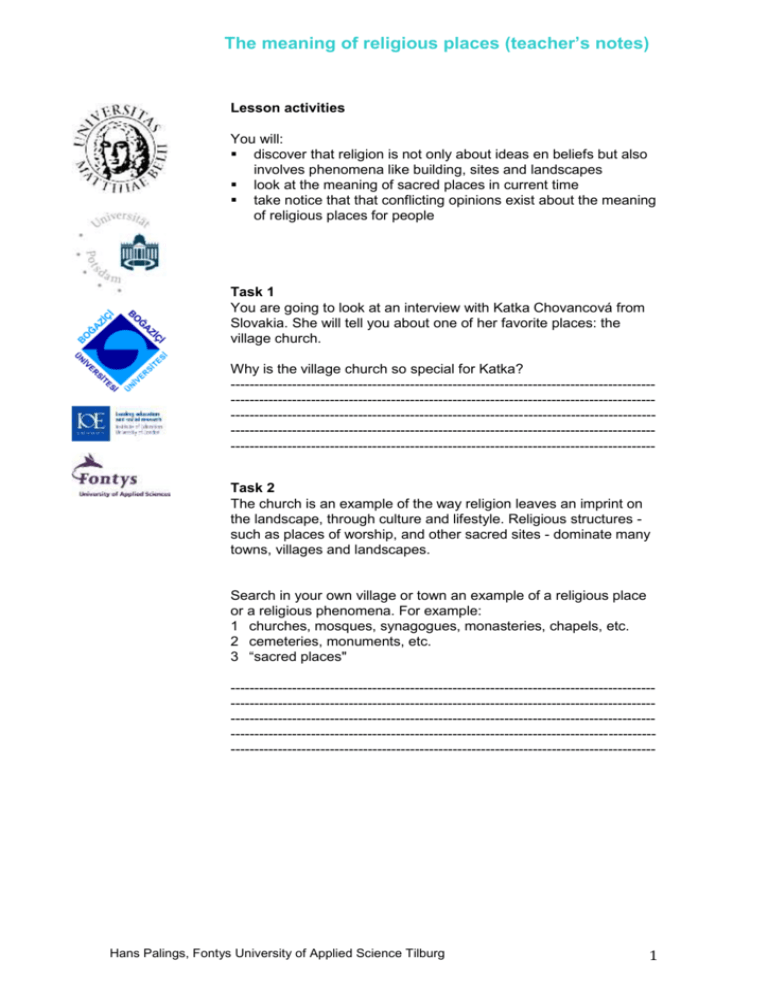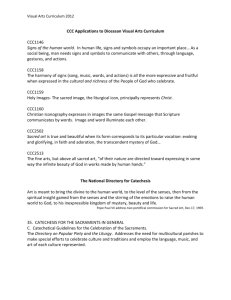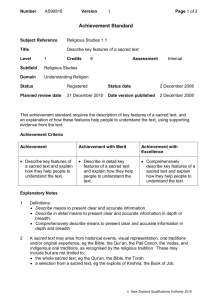The meaning of religious places
advertisement

The meaning of religious places (teacher’s notes) Lesson activities You will: discover that religion is not only about ideas en beliefs but also involves phenomena like building, sites and landscapes look at the meaning of sacred places in current time take notice that that conflicting opinions exist about the meaning of religious places for people Task 1 You are going to look at an interview with Katka Chovancová from Slovakia. She will tell you about one of her favorite places: the village church. Why is the village church so special for Katka? -------------------------------------------------------------------------------------------------------------------------------------------------------------------------------------------------------------------------------------------------------------------------------------------------------------------------------------------------------------------------------------------------------------------------------------------------------------Task 2 The church is an example of the way religion leaves an imprint on the landscape, through culture and lifestyle. Religious structures such as places of worship, and other sacred sites - dominate many towns, villages and landscapes. Search in your own village or town an example of a religious place or a religious phenomena. For example: 1 churches, mosques, synagogues, monasteries, chapels, etc. 2 cemeteries, monuments, etc. 3 “sacred places" -------------------------------------------------------------------------------------------------------------------------------------------------------------------------------------------------------------------------------------------------------------------------------------------------------------------------------------------------------------------------------------------------------------------------------------------------------------- Hans Palings Fontys, Tilburg Hans Palings, Fontys University of Applied Science Tilburg 1 1 The meaning of religious places (teacher’s notes) Katka has a strong ‘sense of place’ towards the village church. According to the American geographer Yi Fu Tuan, a place comes into existence when humans give meaning to the place. The term place may refer to buildings, cities, landscapes, etc. Some places, however, have been given stronger meanings, names or definitions by society than others. These are the places that are said to have a strong sense of place. Geographers, sociologists and urban planners study why certain places hold special meaning to particular people or peoples. Places said to have a strong ‘sense of place’ have a strong identity and character that is deeply felt by local inhabitants and by many visitors. Most religions designate certain places as sacred or holy, and this designation often encourages believers to visit those places in pilgrimage and puts responsibilities on religious authorities to protect them for the benefit of future generations. Places with a strong religious meaning are known as sacred places. We can identify three features of a ‘sacred’ place: 1) they are 'sacred’ places for their followers, they give meaning to the place. 2) they often have 'scenic' qualities 3) the place might be a 'tourist' attraction to visitors, a must-see venue. Task 3 (group work) There are still a lot of places of worship and sacred places in the world. A Discuss with your group members examples of religious places in the world which match the features mentioned before (1 'sacred’ places for their followers, 2 'scenic' qualities 3 'tourist' attraction). Write down the names of these places and give arguments for your choice. ------------------------------------------------------------------------------------------------------------------------------------------------------------------------------------------------------------------------------------------------------------------------------------------------------------------------------------------------------------------------------------------------------------------------------------B For this assignment you need a photograph of a ‘sacred place’ You can choose a photograph of a religious site or sacred place somewhere in the world or you can use a photograph a site from your village, town or a surroundings which is seen as sacred or has special meanings for people. Put this photo in the middle of the diagram which is shown on the next page. The teacher will provide a copy of the diagram. Together discuss the questions and write your answers in the diagram. C Exchange the findings with the other groups. What conclusions can be drawn? ------------------------------------------------------------------------------------------------------------------------------------------------------------------------------------------------------------------------------------------------------------------------------------------------------------------------------------------------------------------------------------------------------------------------------------------------------------------------------------------------------------------------------------------------------------------------------------------------------------------------------------------------------- Hans Palings Fontys, Tilburg Hans Palings, Fontys University of Applied Science Tilburg 2 2 The meaning of religious places (teacher’s notes) Task 4 The German sociologist Max Weber spoke of the disenchantment of the world. According to Weber, God, magic, and myth are now replaced with logic and knowledge. The disenchantment he sees as a result from the scientific revolution in the fifteenth and sixteenth centuries. People began to rely more on scientific investigations as the way to truth. This means that people have been detached from the idea that our environment is dominated by mysterious forces, ghosts and demons. This ultimately resulted in a decline of the use and belief in magic, God, and myth. A Describe the different views of Tuan and Weber. ---------------------------------------------------------------------------------------------------------------------------------------------------------------------------------------------------------------------------------------------------------------------------------------------------------------------------------------------------------------------------------------------------------------------------------------------------------------------------------------------------------------------------------------------- B Which point of view do you prefer? That of Tuan or Weber? Give arguments for your choice. ------------------------------------------------------------------------------------------------------------------------------------------------------------------------------------------------------------------------------------------------------------------------------------------------------------------------------------------------------------------------------------------------------------------------------------ Hans Palings Fontys, Tilburg Hans Palings, Fontys University of Applied Science Tilburg 3 3 The meaning of religious places (teacher’s notes) Task 5 Look at the activities and results of task 1 – 4 and answer the questions below What I already knew about this subject? What I find particularly important to remember? Hans Palings Fontys, Tilburg Hans Palings, Fontys University of Applied Science Tilburg What I want to know? 4 4 The meaning of religious places (teacher’s notes) Evaluation Questions (for pupils): This activity has been exploring some aspects of religious sites and sacred places and the meaning of them for people. What have you understood that you did not already know? What did you like about this work? Please explain why. What did you dislike about this activity? Please explain why. Do you have any further comments? Hans Palings Fontys, Tilburg Hans Palings, Fontys University of Applied Science Tilburg 5 5 The meaning of religious places (teacher’s notes) Teachers Notes This lesson focuses on material aspects of religion. Churches, religious sites, holy places, etc. are visible to us. They were often constructed or created in a different time when they were important landmarks and gave a religious experience to people. In this lesson the students discuss whether these places have still a special meaning for people. Two opposite viewpoints are presented. That of the geographer Yi Fu Tuan and that of the sociologist Max Weber. Tuan believes that people still give meaning to certain places. It is not an intrinsic feature of the building or place that gives it meaning, but why people find it a special place. According to Weber, God, magic, and myth are replaced with logic and knowledge. They lesson takes about one hour and is aimed at age group 14 - 16. The lesson could be taught within Religious education and Geography. As discussion is an important activity, this assignment can also take place in an English language lesson. Two stages, as described in the curriculum framework, are in the center: relating (task 1 -3 ) and deepening understanding (task 4). Task 1: relating The interview with Katka Chovancová from Slovakia is used as a ‘starter’ for this lesson. The transcription of the interview is added to the Teachers Notes. Students will experience that the Church has as special meaning for Katka. This task should make it clear to the students that ‘sense of place’ is the main focus of this assignment. Katka goes to the Church to think about some things and she takes part in the mass. She really likes the church. In her opinion it’s one of the most beautiful ones. Task 2: Relating This question let the students think about possible religious and sacred places in their own environment. Own answers Task 3: Relating A Own answers. For example: Lourdes, the Vatican, Stonehenge, Mecca, etc. On www.sacred-destinations.com 1 a lot of examples can be found. Discuss with the students if the chosen places have the features of a sacred place. B Own answers. C Own answers. The most important conclusions can be written down on Task 4: Deepening understanding A It should be clear to the students that the ideas of Tuan and Weber are opposite. The question is if today we still give meaning to religious places and sites or not. B 1 Own answer The places mentioned on the website are far from complete. Hans Palings Fontys, Tilburg Hans Palings, Fontys University of Applied Science Tilburg 6 6 The meaning of religious places (teacher’s notes) References Feier, A (2003) Religionsgemeinschaften in Deutschland in Praxis Geographie 12/2003 pag. 14 – 19. Braunschweig: Westermann Schulbuchverlag GmbH Knippenberg, H. (2009) Hoe God emigreerde naar Amerika, Geografische bespiegelingen over godsdienst in Europa en de Verenigde Staten. Amsterdam, Vossiuspers UvA Muir, R. (2002) The NEW Reading the Landscape, Fieldwork in Landscape History. Exeter,:University of Exeter Press Park, C. (2004) Religion and geography. Chapter 17 in Hinnells, J. (ed) Routledge Companion to the Study of Religion. London: Routledge Trancription of the interview with Katka Chovancová, Slovakia Now we are in another one of my favorite places, we are in our village church. From time to time I come here to just think about some things. Pretty often, actually on every mass, this lectern is a place from which I read the Holy Bible, so that’s my kind of taking part in the mass. I really like the church; it’s one of the most beautiful ones in my opinion. There’s not much more to say about that, it’s really one of my favorite places. Since we almost have Christmas, I would like to mention, that during Christmas this church is wonderfully decorated. Right in this place there is a big crèche, big star, here is a baby Jesus and every little kid comes here to look at it and gets delighted how everything is so beautiful here. There are also some small cows, donkeys, three kings and actually all we know from the Bible. Then this place is really magical and the most beautiful thing is when during the midnight mass on Christmas Eve the lights are turned off and we all together sing Silent Night Holy Night. Then it’s really amazing. I am a religious person, so I try to attend the holy mass every Sunday and I try to maintain the religious traditions, to behave according to what religion says and preaches. So it’s actually every Sunday, when I have some time then even during the week, I am glad to be in the church, I get there a new energy. I am a Christian – Catholic, exactly said, so I trust in God, like most people in this religion and I regard the Pope as a head of the Church. In my opinion, Church gives answer mostly to people’s spiritual needs. A man has plenty of questions and sometimes it’s very hard to find the answers, so Church is the institution that helps the people in this. As well I think that it helps in a social life and family life, actually, the Church is organizer of many things that help the humanity. My own way of talking to God are my silent prayers in the morning, evening, or actually every time when I need it, when I think I need some help or when I want to talk to someone. I don’t consider myself some religious fan, I think I am just an ordinary believer, who has its own values and follows them. I don’t take everything so seriously like “now I have to do this, then this”, like it is ordered. It depends on everyone, so that’s how I understand it. I don’t think that in the world there is only one true religion, for sure. Every person has its own opinion, so maybe there is only one God, since every religion trusts in their own God, there is a God, it’s the base, but people have different opinions about life. They Hans Palings Fontys, Tilburg Hans Palings, Fontys University of Applied Science Tilburg 7 7 The meaning of religious places (teacher’s notes) live in many countries, it also causes the difference. But I don’t think it is necessary for every person to trust the same thing and do the same things. We are all different so why to try to be the same. Hans Palings Fontys, Tilburg Hans Palings, Fontys University of Applied Science Tilburg 8 8 The meaning of religious places (teacher’s notes) Hans Palings Fontys, Tilburg Hans Palings, Fontys University of Applied Science Tilburg 9 9 The meaning of religious places (teacher’s notes) Park, C. (2004) Religion and geography. Chapter 17, pp 19 – 21 in Hinnells, J. (ed) Routledge Companion to the Study of Religion. London: Routledge SACRED SPACE AND SACRED PLACES One of the more prominent geographical dimensions of religious expression is the notion of sacred space. Most religions designate certain places as sacred or holy, and this designation often encourages believers to visit those places in pilgrimage and puts responsibilities on religious authorities to protect them for the benefit of future generations. Much of the work on this theme builds upon the foundation established by Eliade (1959) in his influential book on The Sacred and the Profane. He explores how ordinary (profane) space is converted into holy (sacred) space, and suggests that this symbolic process reflects the spiritual characteristics associated with both the physical features and the deeper, abstract implications of delimiting a particular site as sacred. Designation of a site as sacred is generally a response to two types of events. Some events (which he calls hierophanic) involve a direct manifestation on earth of a deity, whereas in other (theophanic) events somebody receives a message from the deity and interprets it for others. The religious expression of sacred space varies greatly through space and time, and there is abundant evidence from many cultures that the notion of sacred space is deeprooted and long-lived. Early pagan cultures had their own definition of sacred space that controlled where people went, what they did and how they did it. Sacred sites There is no easy answer to the question of what defines the holiness or sanctity of a place. Yi Fu Tuan (1978 p.84) argues that the true meaning of 'sacred' goes beyond stereotype images of temples and shrines, because "at the level of experience, sacred phenomena are those that stand out from the commonplace and interrupt routine." He puts an emphasis on qualities such as apartness, otherworldliness, orderliness and wholeness in defining what is sacred. Sacred places also share two important properties - they are not transferable (they are valued because of their associated holiness), and they do not need to be re-established with each new generation (there is an inherited appreciation of the holiness of the site). How are sacred sites selected? There is no simple answer because different religions select their sacred sites on different criteria, and the criteria used even within one religion can change through time. Most sacred sites persist, so the inventory at any one point in time is the outcome of many earlier decisions. Some sacred sites are selected because they are associated with people who have some particular religious significance or credibility. For example, many individual pilgrimage sites in Islam and Hinduism mark significant places in the lives of religious founders or leaders. Sites associated with the life of the Buddha - such as his birthplace at Lumbini in Nepal, Bodh-Gaya in India where he received enlightenment, and Sarnath (near Varanasi) where he first preached - are both sacred and heavily visited. Sacred sites are sometimes selected through an association with earlier myths and legends. Many landscape legends invoke the Devil acting as God's agent of retribution, and many prehistoric monuments (stone circles and alignments, single standing stones, remains of chamber graves) have traditionally been explained this way. One of the most popular type of local legend in Europe is those which deal with buildings or towns submerged by the sea, a lake or swamp because of their wicked inhabitants (such as Llyn Syfadon - Llangorse Lake - in Wales). Hans Palings Fontys, Tilburg Hans Palings, Fontys University of Applied Science Tilburg 10 10 The meaning of religious places (teacher’s notes) Many sacred sites are recycled earlier religious sites. There are many examples, including Christian chapels in Egypt converted from pre-Christian rock-tombs, ancient Egyptian temples converted to Christian use, and early Christian churches built within ancient temples in Egypt and Cyprus. Many early British churches were sited either on or adjoining prehistoric or other pagan monuments. The re-use of existing sacred places greatly assisted the early spread of Christianity amongst nonbelievers, but it also ensured that they survived as sacred space (albeit with a different religious orientation). The location of sacred sites in India largely reflects historic and topographic factors. One topographic factor of particular importance in Hinduism is proximity to water. Many sacred sites are concentrated along the seven sacred rivers of the Hindus - the Ganga (Ganges), the Yamuna, the Saraswati, the Narmada, the Indus (Sindhu), the Cauvery and the Godavari. The Ganges is India's holiest of holy rivers and there are many sacred shrines on its banks Hans Palings Fontys, Tilburg Hans Palings, Fontys University of Applied Science Tilburg 11 11






